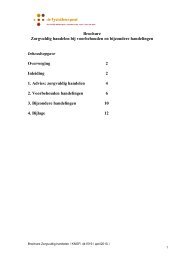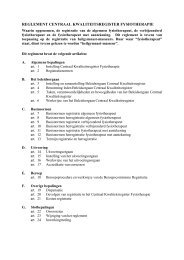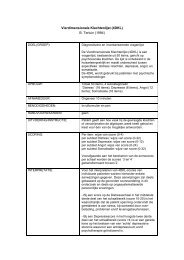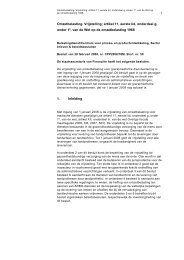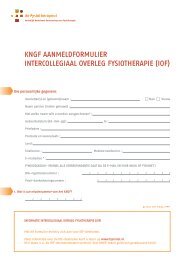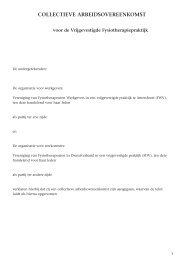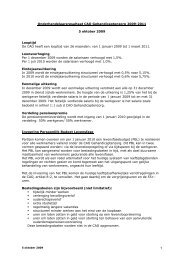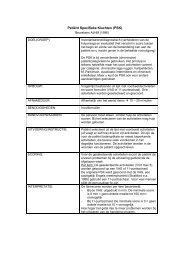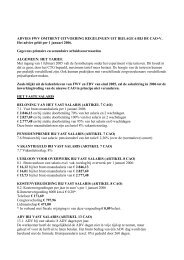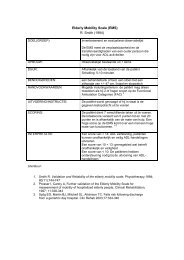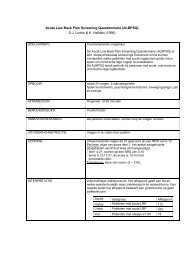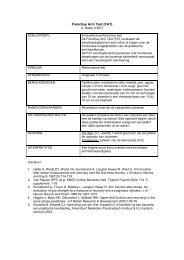Acupuncture and dry-needling for low back pain (Review)
Acupuncture and dry-needling for low back pain (Review)
Acupuncture and dry-needling for low back pain (Review)
Create successful ePaper yourself
Turn your PDF publications into a flip-book with our unique Google optimized e-Paper software.
Giles 2003<br />
Methods<br />
Participants<br />
Interventions<br />
-R<strong>and</strong>omized (method not described). Person drew an envelope out of a box with 150 well-shuffled envelopes, each<br />
containing one of three colour codes (50 envelopes per intervention)<br />
-Data analyst blinded<br />
-Funding: Queensl<strong>and</strong> State Government. Partly supported by Townsville General Hospital.<br />
-Setting: Outpatient <strong>pain</strong> clinic in a hospital setting. Townsville Australia.<br />
-In<strong>for</strong>med written consent was obtained.<br />
-Ethical approval by the Northern Regional Health Authority’s Townsville General Hospital<br />
-Fol<strong>low</strong> up: 115 were r<strong>and</strong>omised. Six dropped out be<strong>for</strong>e treatment <strong>for</strong> reasons not related to outcomes. 69/109<br />
(63.3%) were fol<strong>low</strong>ed.<br />
-Analysis: Based on “intention-to-treat analysis”. Checked <strong>for</strong> possible confounders <strong>and</strong> interactions by multiple<br />
regression <strong>and</strong> logistic regression<br />
109 patients with uncomplicated spinal <strong>pain</strong> <strong>for</strong> a minimum of 13 weeks (average duration was 6.4 years)<br />
Diagnosis: mechanical spinal <strong>pain</strong><br />
Excluded: nerve root involvement, spinal anomalies, pathology other than mild to moderate osteoarthrosis, spondylolisthesis<br />
exceeding grade 1, previous spinal surgery <strong>and</strong> leg length inequality >9 mm<br />
Median age: 39 years old<br />
60 males <strong>and</strong> 49 females<br />
Working status: 29% skilled trade, 20% pensioner or unemployed, 20% manager, clerk or sales, 12% professional,<br />
18% other<br />
Previous treatments: not described<br />
Co-morbidity: not described<br />
1) The clinician determined the <strong>for</strong>m of acupuncture technique. The Near <strong>and</strong> Far technique consists of: <strong>needling</strong><br />
the trigger point <strong>and</strong> distal analgesia producing sympatholytic acupuncture points be<strong>low</strong> the elbow or knee.<br />
<strong>Acupuncture</strong> was per<strong>for</strong>med by one of two experienced acupuncturists using sterile disposable acupuncture guide<br />
tube needles (length 50 mm, gauge 0.25 mm) during 20-minute appointments.<br />
For each patient, 8 to 10 needles were placed in local paraspinal intramuscular maximum <strong>pain</strong> areas <strong>and</strong> approximately<br />
5 needles were placed in distal acupuncture point meridians depending on the spinal <strong>pain</strong> syndrome being treated.<br />
Once patients could tolerate the needles, needle agitation was per<strong>for</strong>med by turning or “flicking” the needles at<br />
approximately 5-minute intervals <strong>for</strong> 20 minutes. The needles were inserted to a length of 20 to 50 mm, in the<br />
maximum <strong>pain</strong> area, <strong>and</strong> up to approximately 5 mm in the distal points.<br />
Two treatments per week up to the defined maximum of 9 weeks of treatment.<br />
R<strong>and</strong>omized to this group: 36. Two were lost be<strong>for</strong>e treatment, 2 during treatment <strong>and</strong> 10 changed treatment because<br />
of no effect<br />
2) Spinal manipulation. 20-minute appointment. High-velocity, <strong>low</strong>-amplitude thrust spinal manipulation to a joint<br />
was per<strong>for</strong>med as judged to be safe <strong>and</strong> usual treatment by the treating chiropractor <strong>for</strong> the spinal level of involvement<br />
to mobilize the spinal joints. Two treatments per week up to a maximum of 9 weeks.<br />
R<strong>and</strong>omized to this group: 36. One was lost be<strong>for</strong>e treatment, 1 during treatment <strong>and</strong> 8 changed treatments because<br />
of “no effect”<br />
3) A medication could be selected that had not already been tried by a patient r<strong>and</strong>omised into the mediation arm of<br />
the study. The patients normally were given Celecoxib (200 to 400 mg/day) unless it had previously been tried. The<br />
next drug of choice was Rofecoxib (12.5 to 25 mg/day) fol<strong>low</strong>ed by paracetamol (up to 4 g/day). Doses, left to the<br />
sports physician’s discretion, were related particularly to the patient’s weight, with the severity of symptoms playing<br />
a minor role. The treating sports physician also was allocated 20 minutes <strong>for</strong> fol<strong>low</strong>-up visits.<br />
R<strong>and</strong>omized to this group: 43. Three were lost be<strong>for</strong>e treatment <strong>and</strong> 18 changed treatment (11 <strong>for</strong> “no effect” <strong>and</strong><br />
8 <strong>for</strong> “side effects”)<br />
<strong>Acupuncture</strong> <strong>and</strong> <strong>dry</strong>-<strong>needling</strong> <strong>for</strong> <strong>low</strong> <strong>back</strong> <strong>pain</strong> (<strong>Review</strong>)<br />
Copyright © 2011 The Cochrane Collaboration. Published by John Wiley & Sons, Ltd.<br />
33



